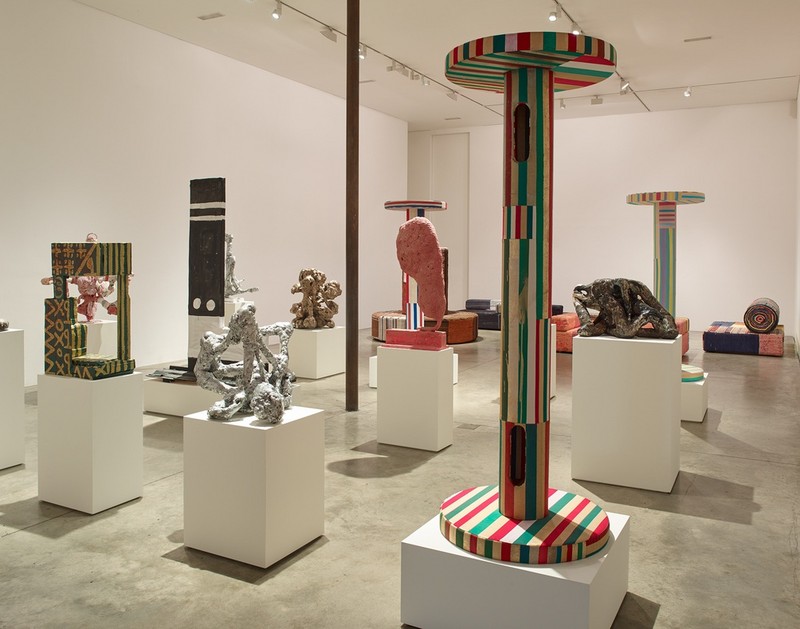Tal R
23 Apr - 30 May 2015

Installation View, Tal R, Chimney school of sculpture
23 April - 30 May 2015.
Gallery I, Victoria Miro, 16 Wharf Road London N1 7RW
23 April - 30 May 2015.
Gallery I, Victoria Miro, 16 Wharf Road London N1 7RW
TAL R
Chimney school of sculpture
23 April - 30 May 2015
Victoria Miro is delighted to present Chimney school of sculpture, an exhibition of new work by the Copenhagen-based artist Tal R.
The exhibition is accompanied by a fully illustrated catalogue, with essay by Tom Morton, view an online version.
Tal R has often used the word 'kolbojnik', meaning leftovers in Hebrew, to describe his practice of sourcing and collecting a wide range of imagery, figurative and abstract, from high and low culture. Installed collectively, Tal R’s works can give the impression of a group show, as adherence to a single aesthetic style is eschewed in favour of a non-hierarchical exploration of material and form. This will be explored in the exhibition, which stages sculptures alongside furniture works and a series of paintings and works on paper.
The lower gallery will be populated by a disparate collection of ceramic, creature-like sculptures. Tal R has employed a process of Raku firing, an ancient technique which originated in sixteenth-century Japan. The process produces notoriously unpredictable results – the clay’s surface is blackened or whitened according to the intensity of its exposure to the smoke and is liable to crack or even explode, a volatility that has drawn the artist to the material.
Alongside the Raku sculptures will be a number of minimalist sculptures of fabric-covered wood. These larger-than-life flumes, with candy-cane stripes and built-in air vents, call to mind to the industrial chimney. However, these works are divorced from any functioning system. Instead they suggest a joyfulness that rebukes a factory logic of inputs and outputs, and embody a stranger and less quantifiable process.
Tal R is also known for producing unique, hand-made sofas, or ‘opiumbeds’, which are made from old and new rugs sourced throughout Scandinavia and treated with paint and dye in the studio. A number of these patchworked pieces of furniture will provide another perspective from which to view – or from which to be viewed by – the sculptures. Exploring the domestic quality of furniture as an artistic medium, Tal R plays with the boundary between art and life. Neither the practical purpose of these works nor their aesthetic qualities take categorical precedence. The idea of the opium bed suggests a hazy, latent space of unfettered thinking, the functional object delineating a non-functional space of thought.
The upstairs floor of the gallery space will be taken up with a self-contained corridor structure stretched over with canvas material. Within it are paintings and works on paper, all depicting a closed blind. Repeated across the walls of an enclosed space, this representation of shuttered vision conveys a visceral sense of interiority and positions the viewer in an ambiguous space that is neither inside nor outside.
Chimney school of sculpture
23 April - 30 May 2015
Victoria Miro is delighted to present Chimney school of sculpture, an exhibition of new work by the Copenhagen-based artist Tal R.
The exhibition is accompanied by a fully illustrated catalogue, with essay by Tom Morton, view an online version.
Tal R has often used the word 'kolbojnik', meaning leftovers in Hebrew, to describe his practice of sourcing and collecting a wide range of imagery, figurative and abstract, from high and low culture. Installed collectively, Tal R’s works can give the impression of a group show, as adherence to a single aesthetic style is eschewed in favour of a non-hierarchical exploration of material and form. This will be explored in the exhibition, which stages sculptures alongside furniture works and a series of paintings and works on paper.
The lower gallery will be populated by a disparate collection of ceramic, creature-like sculptures. Tal R has employed a process of Raku firing, an ancient technique which originated in sixteenth-century Japan. The process produces notoriously unpredictable results – the clay’s surface is blackened or whitened according to the intensity of its exposure to the smoke and is liable to crack or even explode, a volatility that has drawn the artist to the material.
Alongside the Raku sculptures will be a number of minimalist sculptures of fabric-covered wood. These larger-than-life flumes, with candy-cane stripes and built-in air vents, call to mind to the industrial chimney. However, these works are divorced from any functioning system. Instead they suggest a joyfulness that rebukes a factory logic of inputs and outputs, and embody a stranger and less quantifiable process.
Tal R is also known for producing unique, hand-made sofas, or ‘opiumbeds’, which are made from old and new rugs sourced throughout Scandinavia and treated with paint and dye in the studio. A number of these patchworked pieces of furniture will provide another perspective from which to view – or from which to be viewed by – the sculptures. Exploring the domestic quality of furniture as an artistic medium, Tal R plays with the boundary between art and life. Neither the practical purpose of these works nor their aesthetic qualities take categorical precedence. The idea of the opium bed suggests a hazy, latent space of unfettered thinking, the functional object delineating a non-functional space of thought.
The upstairs floor of the gallery space will be taken up with a self-contained corridor structure stretched over with canvas material. Within it are paintings and works on paper, all depicting a closed blind. Repeated across the walls of an enclosed space, this representation of shuttered vision conveys a visceral sense of interiority and positions the viewer in an ambiguous space that is neither inside nor outside.
